Ankle inversion strengthening
The seated ankle inversion exercise strengthens the ankle’s stabilising muscles, making it ideal for preventing injuries in court and field-based sports. This exercise improves ankle stability, supports better balance, and helps reduce the risk of sprains, providing a strong foundation for dynamic athletic movements.
Seated heel raise
The seated heel-raise exercise is a gentle movement designed for the early stages of Achilles tendon rehabilitation. This light exercise activates the calf muscles, promoting blood flow and gradual strength building, supporting safe and effective recovery of the Achilles tendon.
Seated foot lift
The seated toe-lift exercise targets the muscles at the front of the ankle, enhancing stability and control. This exercise is ideal for improving ankle strength and balance, supporting better movement mechanics, and reducing the risk of ankle-related injuries.
Romanian hamstring dip
The single-leg Romanian deadlift strengthens the hamstrings, glutes, and core while improving balance and stability. Ideal for building lower body strength and enhancing hip control, this exercise promotes proper movement mechanics, reduces injury risk, and supports athletic performance in dynamic activities.
Ankle resisted eversion
The ankle evertor strengthening exercise with a theraband targets the outer ankle muscles, essential for preventing ankle sprains. This exercise improves ankle stability, enhances lateral control, and builds resilience, making it ideal for individuals prone to ankle injuries or those looking to boost lower limb stability.
Trunk rotation stretch
The trunk rotation stretch in the supine position gently releases upper back tension, promoting flexibility and relaxation along the spine. Ideal for relieving stiffness and improving rotational mobility, this stretch supports better posture and reduces upper body discomfort.
Theraband neck forward pull
The theraband neck forward pull exercise builds endurance in the neck muscles, supporting better posture and neck stability. Ideal for individuals looking to strengthen neck control and reduce strain, this exercise promotes sustained muscle endurance, essential for long periods of sitting or desk work.
Trapezius shoulder shrug
Trapezius shoulder shrugs relieve tension in the postural muscles, promoting blood flow and reducing neck pain associated with prolonged sitting. This exercise supports better circulation, eases muscle tightness, and enhances upper body posture, making it ideal for desk workers and individuals with neck discomfort.
Shoulder press
The shoulder press is a powerful exercise for strengthening the shoulder muscles, enhancing upper body stability and endurance. Ideal for building shoulder strength and improving overhead mobility, this movement supports functional strength and promotes balanced muscle development.
Resistance band behind the head pull
The resistance band behind-the-head pull exercise activates postural muscles, helping improve posture by increasing muscle tone and stability in the upper back and shoulders. This exercise supports better alignment, reduces slouching, and promotes a strong, upright posture, making it ideal for combating the effects of prolonged sitting.
Resistance band direct pull back
The resistance band direct pull-back exercise strengthens the muscles at the back of the shoulders, encouraging a naturally better posture. Ideal for counteracting forward shoulder rounding, this exercise improves upper back stability, enhances shoulder alignment, and supports an upright posture.
Resistance band shoulder retraction
The resistance band shoulder retraction exercise targets the upper back and shoulder muscles, helping to alleviate neck and upper back pain and stiffness caused by prolonged computer use. By strengthening postural muscles, this exercise rebalances your posture, promoting alignment and reducing tension.
Resistance band shoulder external rotation
The rotator cuff resisted external rotation exercise stabilizes the shoulder and is essential in the first stage of recovery from a rotator cuff tear. This movement gently activates the shoulder’s stabilizing muscles, promoting controlled strength, reducing strain, and supporting safe progression through rehabilitation.
ITB syndrome in long-distance runners and walkers
Ilio-tibial band injury and side-knee pain seen in runners. The involvement of hip and pelvis alignment in running is important.
Hip soreness in hikers and runners: bursitis and gluteal tendinopathy
Hip pain in hikers & runners
Core stability and control
How core muscles are protectors of your spine, and how do you make sure that their natural muscle tone supports your posture. The key is not to consciously keep your core activated - that is a very outdated. The key is to have that core muscle tone so it supports you without thinking about. That is core stability and core control!
Side-lying rotator cuff
The side-lying shoulder rotator cuff strengthening exercise is a gentle starting point for shoulder rehabilitation, ideal for acute shoulder pain and frozen shoulder. This low-impact movement activates stabilizing muscles without strain, promoting mobility, reducing pain, and supporting gradual recovery in a safe, controlled manner.


















